The Ultimate Guide to 3-Point Log Hitches
If you’ve ever had to clear trails and move logs around your property, you know how dangerous and cumbersome log skidding can be. Heavy and bulky, it’s a process that requires focus and attention to detail, not only on the hauled logs but also on the equipment and surroundings.
Chances are, you’ve used a three-point hitch to skid material about. Whether you’re an experienced pro with using them or just a little green behind the ears, there’s always something new you could learn.
At Earth and Turf Attachments, maximizing the utility of your compact tractor is our mission. That’s why we’re talking about 3-point log hitches—how they work, the benefits of using a hitch, how they compare to similar equipment, and choosing the right log hitch for your equipment.
Ready? Let’s hook up with some knowledge!
No time to read? Here's a summary:
- A 3-point log hitch is a tractor attachment that lifts one end of a log, making it easier and safer to skid to a desired location.
- It is a versatile and cost-effective alternative to more expensive log-moving equipment like skidders and grapples for smaller operations.
- The benefits of using a 3-point log hitch include improved safety by reducing manual labor, enhanced efficiency, and increased productivity.
- When choosing a hitch, key factors to consider are tractor compatibility, lifting capacity, build quality, and budget.
Keep reading to find out more!
What is a 3-Point Hitch, And How Does It Work?
In order to understand 3-point log hitches, let’s look at the 3-point hitch system on which it’s built.
Also known in British English as a 3-point linkage, a 3-point hitch is a mount for attaching plows and other implements to a tractor. The name comes from the three points of the hitch that resemble a triangle or the letter A and is one of the simplest ways to create a frame that will withstand the repeated stresses of pulling or lifting forces. Its triangular shape makes a robust frame to attach various implements to, such as log hitches, ballast boxes, carts, and other similar implements.
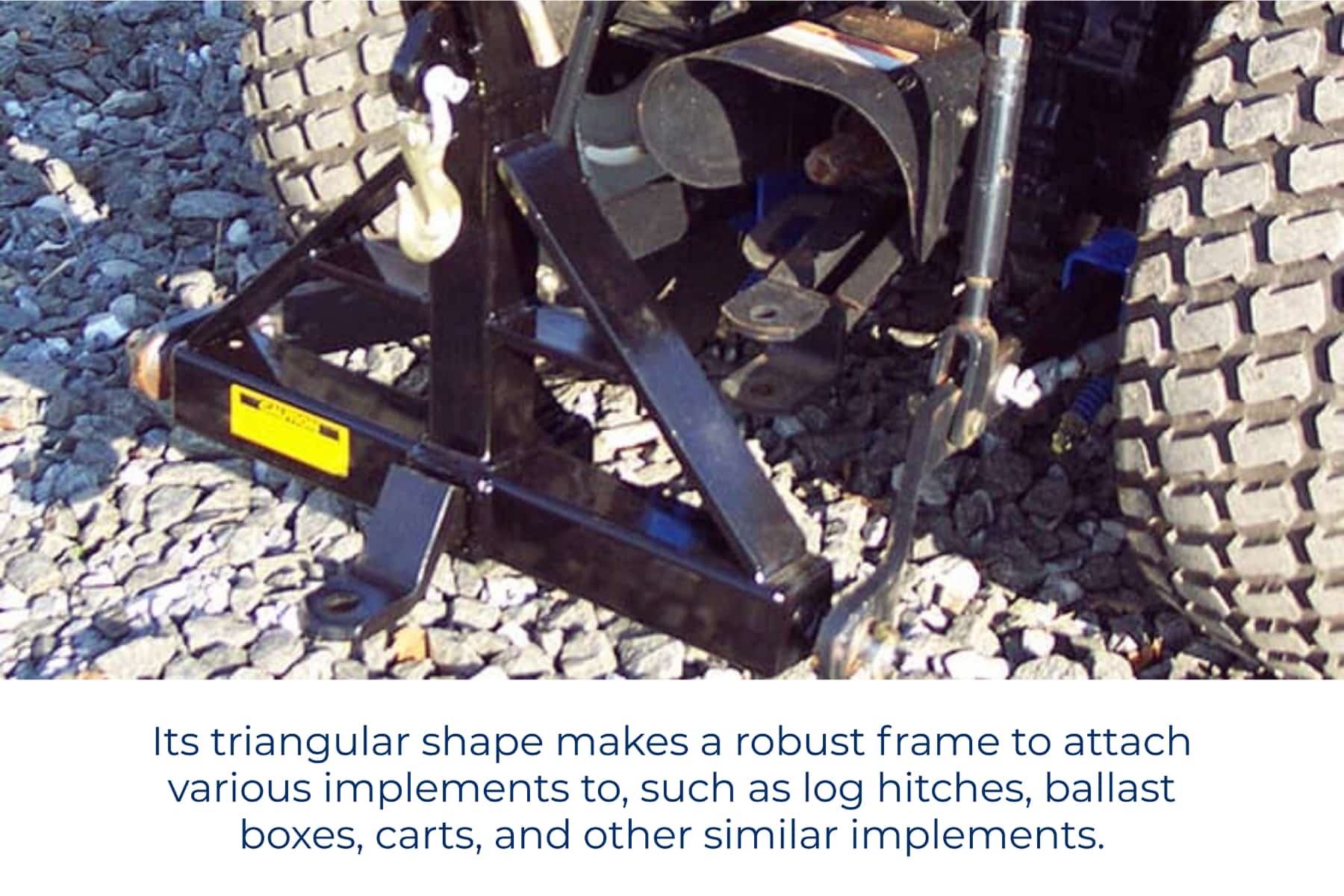
Here’s a fun fact: The 3-point hitch was invented by Irish inventor Harry Ferguson, known for being the first person in Ireland to build and fly his own airplane and for developing the first four-wheel-drive Formula One car. If that name sounds familiar, the company he founded later merged with the Massey-Harris company to become Massey-Ferguson.
We’re talking about the 3-point hitch system because it forms the basis of the 3-point log hitch, which is the subject of this blog. By understanding the hitch mechanism, we can also know that all other hitch attachments are designed to plug into and take advantage of the leverage provided by the physics of the hitch mechanism itself.
Now that we’ve discussed the 3-point hitch system, let’s look into the log hitch.
What is a 3-Point Log Hitch?
A 3-point log hitch is a mechanism designed to haul logs. It’s a hook mounted on the hitch mechanism that lifts one end of a log so that a driver can drag or “skid” the log to a desired location.
You can wrap a chain around the log to hook the log up to the hitch or use rope to tie a timber hitch around the log. By attaching a log to the log hitch, you effectively lift one end of the log, reducing the surface area of the log’s contact with the ground, letting you skid logs around while minimizing ground disturbance and damage to the woodlot. Lifting one end also keeps the log cleaner by preventing dirt and debris from getting onto the log during transport. Log hitches transform compact tractors into multi-functional workhorses.
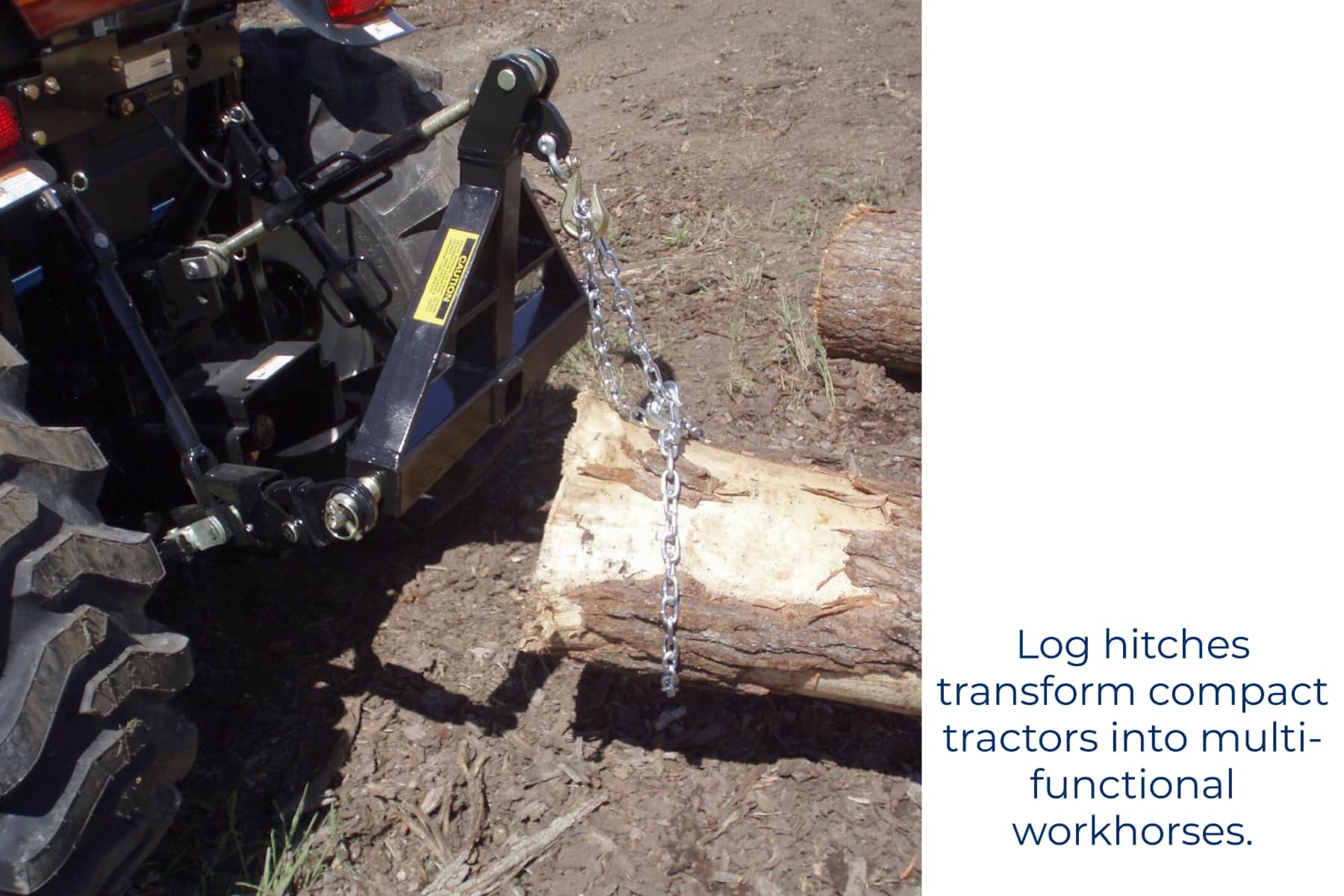
Here’s how log hitches can help you work more efficiently:
- Versatility: Log hitches can be used with various tractors, making them versatile tools for operations. Whether working on a small farm or managing a forestry operation, a 3-point log hitch can adapt to your needs, such as firewood collection and trail maintenance.
- Efficient log skidding: Log hitches allow compact tractors to drag logs from wooded areas to a central location, simplifying clearing land or gathering firewood. Hitching becomes more efficient by reducing the log’s contact with the ground during movement. Accessories such as a log skidding cone can make skidding even simpler by reducing snagging, which further reduces damage to the surrounding fauna in turn.
- Improved safety: Manually moving logs can be dangerous, with risks of injury from lifting heavy objects or getting caught between logs. The 3-point log hitch minimizes risks by allowing the tractor to do the heavy lifting, keeping operators safe. Log hitches keep the log secure during transport, reducing the risk of damaging the tractor or injuring workers. Training and proper use of PPE are essential to enhancing safety around logging sites.
- Improved productivity: Log hitches make it easier to move heavy logs, enabling farmers and landowners to work quickly, efficiently, and with less physical strain.
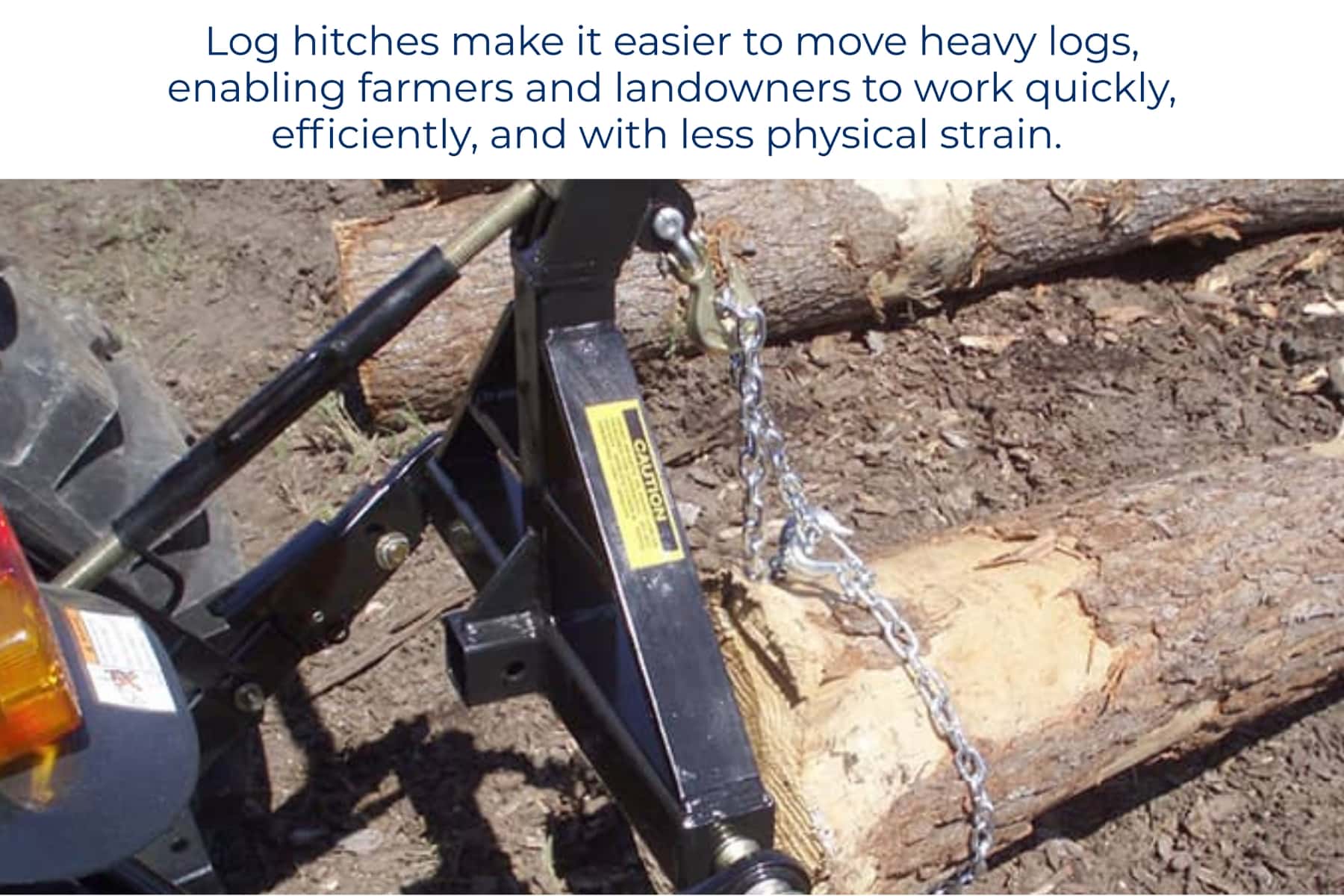
Compared to specialized log-moving equipment like skidders or grapples, the 3-point log hitch is a more affordable option that still delivers excellent performance.
- Less damaging to the surrounding environment: A compact tractor's maneuverability allows it to drag the logs out with fewer, shallower tracks and less damage to surrounding foliage than driving something larger through the forest, like a skidder.
How Does a Log Hitch Compare to Other Log-Moving Equipment?
When it comes to moving logs, there are several equipment options available, each with its own set of advantages and disadvantages. Let's compare the 3-point log hitch to some of the other common log-moving equipment:
- Skidders: Skidders are heavy-duty machines designed explicitly for dragging logs out of the forest. While they are highly effective, they are also expensive and require significant maintenance. In contrast, a 3-point log hitch is a more affordable option that can be attached to a standard tractor, making it accessible to smaller operations.
- Log Arches: Log arches are wheeled devices that lift one end of the log off the ground, reducing drag and making it easier to move logs manually or with an ATV. While effective for smaller operations, they lack the power and efficiency of a tractor-mounted 3-point log hitch.
- Grapples: Grapples, like our Hybrid Grapple™, are attachments mounted on the front of a loader or skid steer to grab and move logs. They offer excellent control and precision but are typically more expensive than a 3-point log hitch and require a compatible machine.
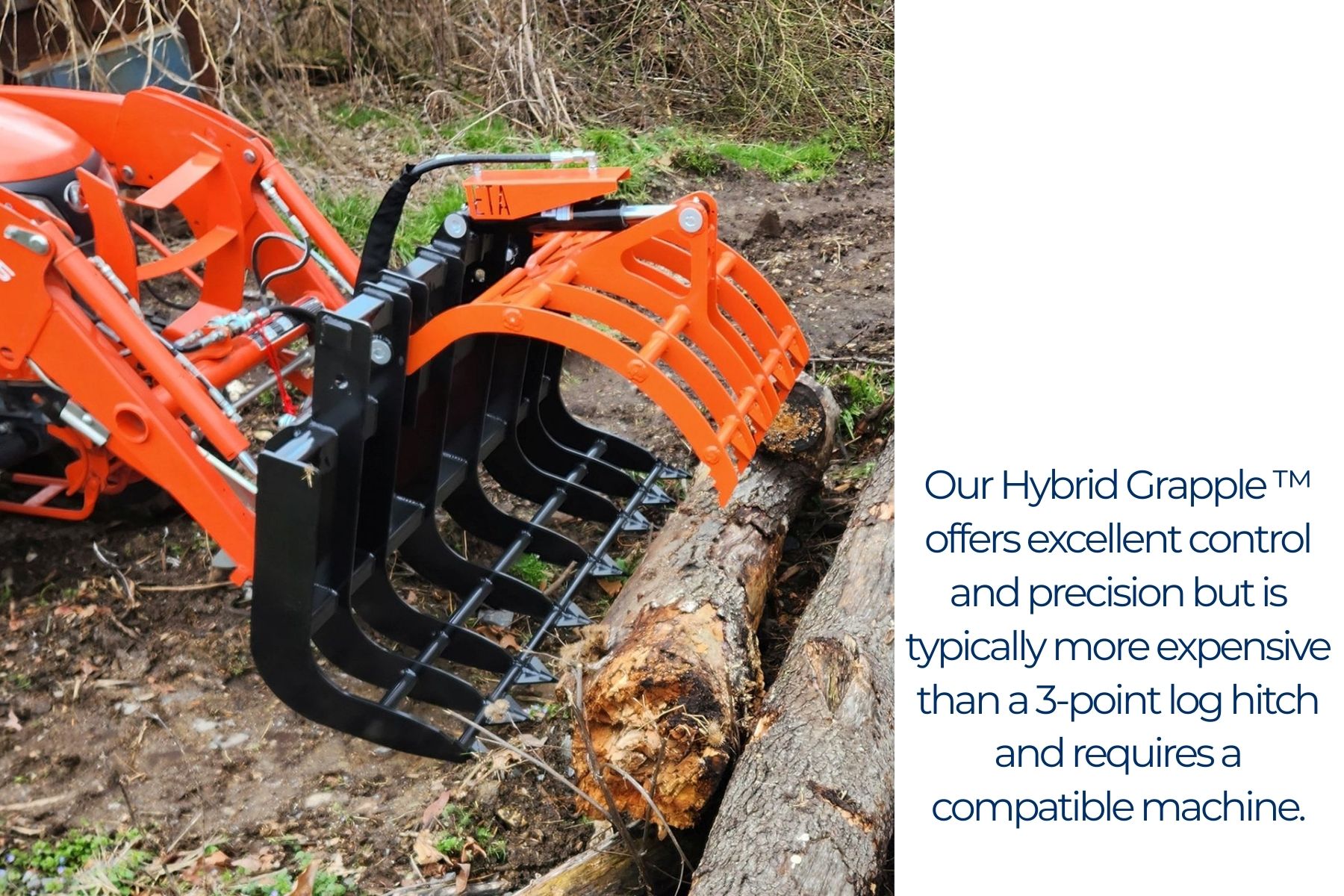
Overall, the 3-point log hitch stands out for its affordability, ease of use, and compatibility with standard tractors, making it an excellent choice for many log-moving tasks.
Pros and Cons of Using a 3-Point Log Hitch
Pros:
- Ease of Use: The 3-point hitch system is designed for quick and easy attachment and detachment, allowing operators to switch between tasks with minimal downtime.
- Stability: The triangular configuration of the three-point hitch provides stability and control, ensuring safe and efficient log transport.
- Compatibility: Most tractors have a 3-point hitch system, making it easy to find compatible attachments.
Cons:
- Limited Lifting Capacity: The lifting capacity of a 3-point log hitch is limited by the tractor's hydraulic system and the hitch's design. Additional equipment may be required for extremely large or heavy logs.
- Terrain Limitations: While effective on flat or gently sloping terrain, a 3-point log hitch may struggle on steep or uneven ground where a skidder or grapple might perform better. Consider the possibility that the tractor might roll over in the event that the tractor loses stability while log skidding, and consider a Roll Over Protection System (ROPS)
- Dependence on Tractors: The effectiveness of a 3-point log hitch is directly tied to the tractor's capabilities. A low-powered or poorly maintained tractor may limit the hitch's performance.
How to Choose the Right 3-Point Log Hitch for Your Needs
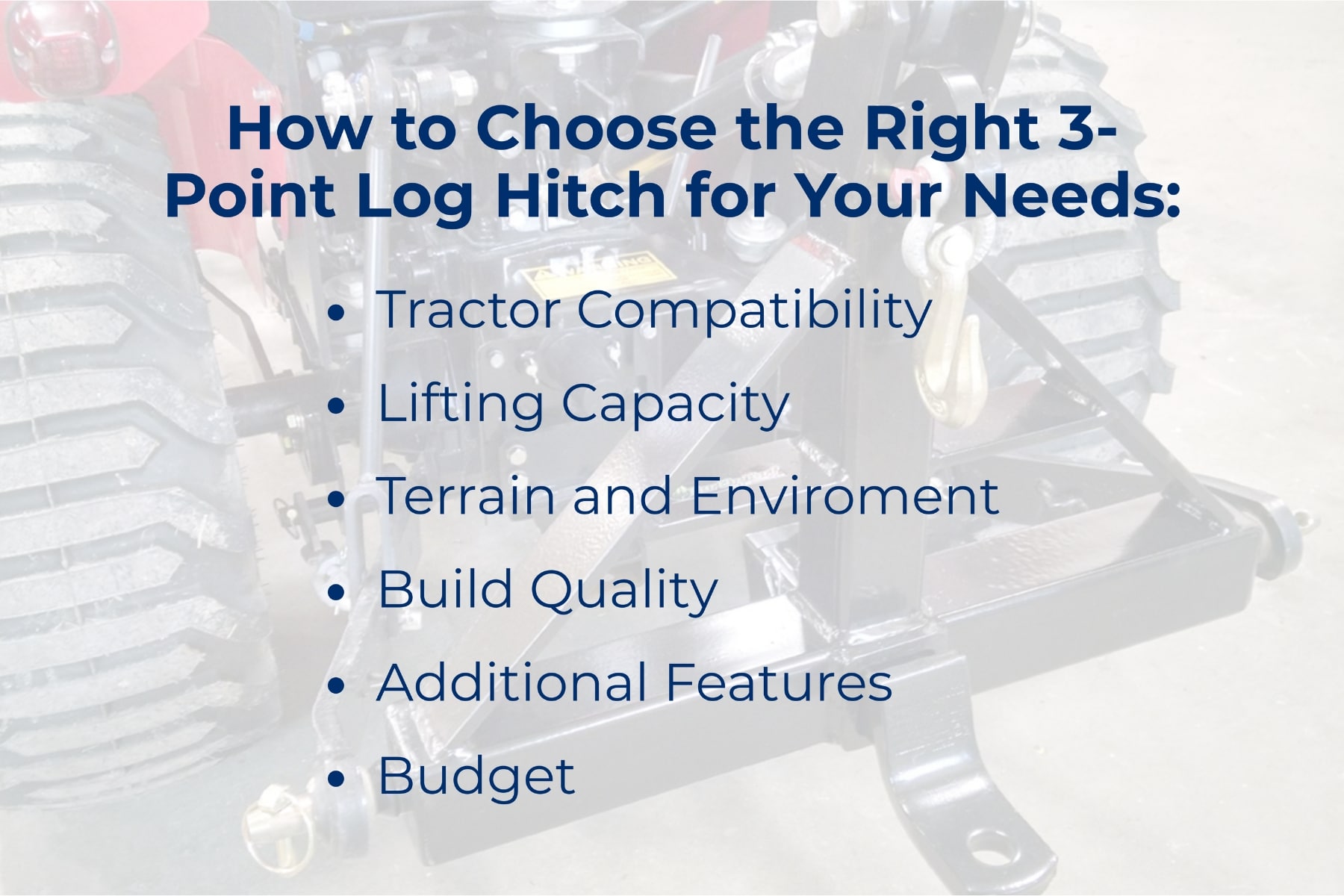
Selecting the right 3-point log hitch involves considering several factors to ensure it meets your specific requirements:
- Tractor Compatibility: Ensure the hitch is compatible with your tractor's three-point hitch system. Check the hitch category (Category 1, 2, or 3) and ensure it matches your tractor's specifications.
- Lifting Capacity: Consider the size and weight of the logs you plan to move. Choose a hitch with a lifting capacity that meets or exceeds your needs to ensure safe and efficient operation.
- Terrain and Environment: Assess the terrain and conditions where you'll use the hitch. If you work on steep or uneven ground, look for a hitch with features that enhance stability and control.
- Build Quality: Look for a hitch made from durable materials that can withstand the rigors of log handling. High-quality construction ensures longevity and reliability.
- Additional Features: Some 3-point log hitches have extra features, such as adjustable hooks, chains, or winches. Consider these options if they align with your specific needs.
- Budget: Determine your budget and find a hitch that offers the best value for your investment. While it's important to prioritize quality and performance, there are options available to suit various price ranges. Many vendors also provide financing.
Conclusion
In forestry and agriculture, the 3-point log hitch is an invaluable tool that offers versatility, efficiency, and safety. By understanding its uses, advantages, and the factors to consider when choosing the right hitch, you can make an informed decision to enhance your operations.
As you evaluate your options, consider the compatibility with your tractor, the lifting capacity required, and the environmental conditions in which you'll be working. With the right 3-point log hitch, you'll be well-equipped to tackle the challenges of log handling and maximize your productivity.
At Earth and Turf Attachments, we want you to work smart, and our hitch attachments are designed to work hard. Since 1997, we’ve been building specialized attachments and accessories in Lancaster County, Pennsylvania, to address specific needs that the major company tractor manufacturers have not met.
Contact us today and find out how we can help you work smarter!






